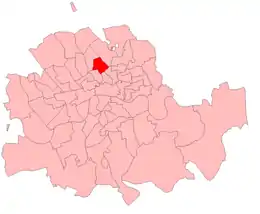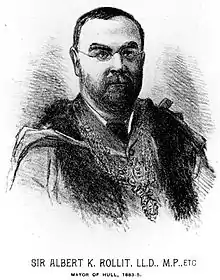Islington South (UK Parliament constituency)
Islington South was a parliamentary constituency in the Metropolitan Borough of Islington in North London. It returned one Member of Parliament to the House of Commons of the Parliament of the United Kingdom.
| Islington South | |
|---|---|
| Former Borough constituency for the House of Commons | |
| 1885–1950 | |
| Number of members | one |
| Replaced by | Islington South West |
| Created from | Finsbury |
The constituency was created for the 1885 general election, and abolished for the 1950 general election.
Boundaries
1885–1918

The constituency was defined as comprising 3 wards of the parish of Islington: Barnsbury, St Mary and St Peter. These wards were used for the election of vestryman under the Metropolis Management Act 1855.[1]
1918–1950


Under the Representation of the People Act 1918 constituencies in the County of London were redefined in terms of the Metropolitan Boroughs created in 1900. The constituency was defined as comprising three wards of the Metropolitan Borough of Islington having the same names as the previous wards: Barnsbury, St Mary and St Peter.[1]
Members of Parliament
| Election | Member | Party | |
|---|---|---|---|
| 1885 | Henry Spicer | Liberal | |
| 1886 | Sir Albert Rollit | Conservative | |
| 1906 | Thomas Wiles | Liberal | |
| 1918 | Charles Higham | Unionist | |
| 1922 | Charles Garland | Unionist | |
| 1923 | William Cluse | Labour | |
| 1931 | Tom Howard | Conservative | |
| 1935 | William Cluse | Labour | |
| 1950 | constituency abolished | ||
Elections
Elections in the 1880s
| Party | Candidate | Votes | % | ±% | |
|---|---|---|---|---|---|
| Liberal | Henry Spicer | 3,050 | 54.9 | ||
| Conservative | Henry Wildey Wright[3] | 2,502 | 45.1 | ||
| Majority | 548 | 9.8 | |||
| Turnout | 5,552 | 79.0 | |||
| Registered electors | 7,024 | ||||
| Liberal win (new seat) | |||||

| Party | Candidate | Votes | % | ±% | |
|---|---|---|---|---|---|
| Conservative | Albert Rollit | 2,774 | 55.7 | +10.6 | |
| Liberal | Henry Spicer | 2,208 | 44.3 | -10.6 | |
| Majority | 566 | 11.4 | N/A | ||
| Turnout | 4,982 | 70.9 | −8.1 | ||
| Registered electors | 7,024 | ||||
| Conservative gain from Liberal | Swing | +10.6 | |||
Elections in the 1890s
| Party | Candidate | Votes | % | ±% | |
|---|---|---|---|---|---|
| Conservative | Albert Rollit | 3,194 | 52.6 | −3.1 | |
| Liberal | William Digby | 2,873 | 47.4 | +3.1 | |
| Majority | 321 | 5.2 | −6.2 | ||
| Turnout | 6,067 | 73.1 | +2.2 | ||
| Registered electors | 8,299 | ||||
| Conservative hold | Swing | −3.1 | |||
| Party | Candidate | Votes | % | ±% | |
|---|---|---|---|---|---|
| Conservative | Albert Rollit | 3,563 | 60.3 | +7.7 | |
| Liberal | Heber Hart | 2,342 | 39.7 | −7.7 | |
| Majority | 1,221 | 20.6 | +15.4 | ||
| Turnout | 5,905 | 71.6 | −1.5 | ||
| Registered electors | 8,244 | ||||
| Conservative hold | Swing | +7.7 | |||
Elections in the 1900s
| Party | Candidate | Votes | % | ±% | |
|---|---|---|---|---|---|
| Conservative | Albert Rollit | 3,881 | 70.0 | +9.7 | |
| Liberal | James Andrew Strahan | 1,665 | 30.0 | −9.7 | |
| Majority | 2,216 | 40.0 | +19.4 | ||
| Turnout | 5,546 | 63.1 | −8.5 | ||
| Registered electors | 8,796 | ||||
| Conservative hold | Swing | +9.7 | |||

| Party | Candidate | Votes | % | ±% | |
|---|---|---|---|---|---|
| Liberal | Thomas Wiles | 3,606 | 55.7 | +25.7 | |
| Conservative | Albert Rollit | 1,991 | 30.8 | −39.2 | |
| Ind. Conservative | W. Hunt[n 1] | 870 | 13.5 | New | |
| Majority | 1,615 | 24.9 | N/A | ||
| Turnout | 6,467 | 77.3 | +14.2 | ||
| Registered electors | 8,361 | ||||
| Liberal gain from Conservative | Swing | +32.5 | |||
Elections in the 1910s
| Party | Candidate | Votes | % | ±% | |
|---|---|---|---|---|---|
| Liberal | Thomas Wiles | 3,917 | 55.1 | -0.6 | |
| Conservative | David Faber | 3,187 | 44.9 | +14.1 | |
| Majority | 730 | 10.2 | -14.7 | ||
| Turnout | 8,268 | 85.9 | +8.6 | ||
| Liberal hold | Swing | ||||
| Party | Candidate | Votes | % | ±% | |
|---|---|---|---|---|---|
| Liberal | Thomas Wiles | 3,494 | 55.5 | +0.4 | |
| Conservative | Lionel Wormser Harris | 2,803 | 44.5 | -0.4 | |
| Majority | 691 | 11.0 | +0.8 | ||
| Turnout | 8,268 | 76.2 | -9.7 | ||
| Liberal hold | Swing | ||||
General Election 1914/15:
Another General Election was required to take place before the end of 1915. The political parties had been making preparations for an election to take place and by the July 1914, the following candidates had been selected;
- Liberal: Thomas Wiles
- Unionist:
| Party | Candidate | Votes | % | ±% | |
|---|---|---|---|---|---|
| C | Unionist | Charles Higham | 6,885 | 53.9 | +9.4 |
| Liberal | Thomas Wiles | 5,883 | 46.1 | −9.4 | |
| Majority | 1,002 | 7.8 | N/A | ||
| Turnout | 12,768 | 44.1 | −32.1 | ||
| Registered electors | 28,976 | ||||
| Unionist gain from Liberal | Swing | +9.4 | |||
| C indicates candidate endorsed by the coalition government. | |||||
Elections in the 1920s
| Party | Candidate | Votes | % | ±% | |
|---|---|---|---|---|---|
| Unionist | Charles Garland | 7,877 | 36.1 | −17.8 | |
| Liberal | Thomas Wiles | 7,352 | 33.6 | −12.5 | |
| Labour | Frederick Pethick-Lawrence | 6,634 | 30.3 | New | |
| Majority | 525 | 2.5 | −5.3 | ||
| Turnout | 21,863 | 64.2 | +20.1 | ||
| Registered electors | 34,029 | ||||
| Unionist hold | Swing | −2.7 | |||
| Party | Candidate | Votes | % | ±% | |
|---|---|---|---|---|---|
| Labour | William Cluse | 7,764 | 37.0 | +6.7 | |
| Liberal | Edward Brotherton-Ratcliffe | 7,531 | 35.9 | +2.3 | |
| Unionist | Charles Garland | 5,691 | 27.1 | −9.0 | |
| Majority | 233 | 1.1 | N/A | ||
| Turnout | 20,986 | 60.9 | −3.3 | ||
| Registered electors | 34,462 | ||||
| Labour gain from Unionist | Swing | +2.2 | |||
| Party | Candidate | Votes | % | ±% | |
|---|---|---|---|---|---|
| Labour | William Cluse | 10,347 | 42.8 | +5.8 | |
| Unionist | Tom Howard | 8,668 | 35.9 | +8.8 | |
| Liberal | Edward Brotherton-Ratcliffe | 5,158 | 21.3 | −14.6 | |
| Majority | 1,679 | 6.9 | +5.8 | ||
| Turnout | 24,173 | 69.4 | +8.5 | ||
| Registered electors | 34,818 | ||||
| Labour hold | Swing | −1.5 | |||
| Party | Candidate | Votes | % | ±% | |
|---|---|---|---|---|---|
| Labour | William Cluse | 13,737 | 46.6 | +3.8 | |
| Unionist | Tom Howard | 9,418 | 32.0 | −3.9 | |
| Liberal | Frank Milton | 6,316 | 21.4 | +0.1 | |
| Majority | 4,319 | 14.6 | +7.7 | ||
| Turnout | 29,471 | 66.2 | −3.2 | ||
| Registered electors | 44,490 | ||||
| Labour hold | Swing | +3.9 | |||
Elections in the 1930s
| Party | Candidate | Votes | % | ±% | |
|---|---|---|---|---|---|
| Conservative | Tom Howard | 18,071 | 62.4 | +29.4 | |
| Labour | William Cluse | 10,910 | 37.6 | -9.0 | |
| Majority | 7,161 | 24.8 | N/A | ||
| Turnout | 28,981 | 64.8 | -1.4 | ||
| Conservative gain from Labour | Swing | ||||
| Party | Candidate | Votes | % | ±% | |
|---|---|---|---|---|---|
| Labour | William Cluse | 12,526 | 52.4 | +14.8 | |
| Conservative | Tom Howard | 11,398 | 47.6 | -14.8 | |
| Majority | 1,128 | 4.8 | N/A | ||
| Turnout | 23,924 | 56.7 | -8.1 | ||
| Labour gain from Conservative | Swing | ||||
General Election 1939/40
Another General Election was required to take place before the end of 1940. The political parties had been making preparations for an election to take place and by the Autumn of 1939, the following candidates had been selected;
- Labour: William Cluse[5]
- Conservative: Tom Howard
Elections in the 1940s
| Party | Candidate | Votes | % | ±% | |
|---|---|---|---|---|---|
| Labour | William Cluse | 12,893 | 72.5 | +20.1 | |
| Conservative | Tom Howard | 4,877 | 27.5 | -20.1 | |
| Majority | 8,016 | 45.0 | +40.2 | ||
| Turnout | 17,770 | 64.0 | +3.3 | ||
| Labour hold | Swing | ||||
See also
Notes and References
Notes
- Supported by the Tariff Reform League
References
- Youngs, Frederic A, Jr. (1979). Guide to the Local Administrative Units of England, Vol.I: Southern England. London: Royal Historical Society. pp. 743, 749. ISBN 0901050679.
- British Parliamentary Election Results 1885–1918, FWS Craig
- "Mr Wildey Wright". Islington Gazette. 2 March 1886. p. 2. Retrieved 2 December 2017 – via British Newspaper Archive.
- British Parliamentary Election Results 1918–1949, FWS Craig
- Report of the Annual Conference of the Labour Party, 1939
- Leigh Rayment's Historical List of MPs – Constituencies beginning with "I"
- British Parliamentary Election Results 1885-1918, compiled and edited by F.W.S. Craig (Macmillan Press 1974)
- Debrett’s Illustrated Heraldic and Biographical House of Commons and the Judicial Bench 1886
- Debrett’s House of Commons and the Judicial Bench 1901
- Debrett’s House of Commons and the Judicial Bench 1918